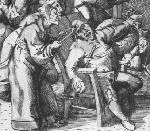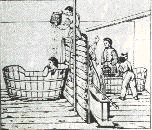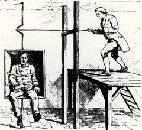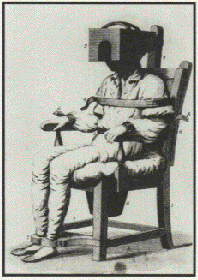The Limbic Region "Emotion Central" Website | home
Phobias | Inhumane & Insane Cures
Inhumane & Insane Cures



Throughout the course of history mankind's treatment of the insane has been, well, insane! While the day-to-day care of patients could be cruel, attempts at curing them could be even crueler. Everything from medieval chiseling of the skull to "let the devil escape" to the 1940's ice-pick lobotomies of Dr. Walter Freeman. In 1276, then Pope John XXI, who wrote several medical treatises, suggested that eating a roasted mouse "doth heal frantick persons." In the 16th Century it was believed that stones in the head caused madness. This belief is perpetuated in the oft-heard cliche "rocks in the head." Dr. Benjamin Rush (1745-1813), a pioneer of early American psychiatry, recommended relentlessly swinging the patient around to "shake out the madness." As the politics of forced treatment once again reared it's ugly head and the short era of moral treatment introduced by Dr. Philippe Pinel faded from sight, novelist Charles Dickens wrote: "Chains, straw, filthy solitude, darkness and starvation; jalap, syrup of buckthorn, tartarised antimony and ipecacuanha administered every spring and fall in fabulous doses to every patient, whether well or ill; spinning in whirligigs, corporal punishment, gagging, continued intoxication; nothing was too wildly extravagant, nothing too monstrously cruel to be prescribed by mad-doctors." Perhaps no single group has undergone more widespread experimentation than the destitute "mentally-ill" in state-run institutions. A major movie production recently filmed at an abandoned state hospital in the city of Danvers, Massachusetts (Session 9), reveals the severity exacted by it's patients. Surgical tables and eerie artifacts left over from more than a century of treating "the mentally-ill" have been left as they were at the hospital, which was abandoned in 1992. Cast and crew members were overwhelmed by the buildings disturbing aura. Said one crew member: "the walls there are very sad, full of hurt, it's not a place that you take lightly."
*****************************************************
"There Are Some Remedies Worse Than The Disease!" (Publius Syrus, First Century B.C.)
*****************************************************
Dr. Daniel Oxenbridge (1576-1642) a London physician, employed the latest methods in 1628 when trying to cure the young wife of a clothier. First he gave her an enema, then he bled her arms, her feet, and her forehead. After that, "once every three or four days, I either bled her or vomited her strongly." He then shaved off all the hair on her head to which he "applied the warm lungs of lambs, sheep and young whelps..."
Dr. Jan Baptista van Helmont (1577-1644) a Flemish physician, argued that water shock - to the brink of near death - could extinguish a mad person's "too violent and exorbitant form of fiery life." Dr. Jan Baptista discovered this cure by observing that "many fools who accidentally fall into water and are dragged out for dead are not only restored to life... but also to the full use of their understanding." Even American physicians experimented with the merits of this European cure. A Delaware physician, writing in an 1802 medical journal, told of the dousing therapy he'd utilized while treating an insane man confined at home. Another American physician who used this form of treatment was a Dr. Willard, who ran a private asylum in a small town near the border of Massachusetts and Rhode Island. Dr. Willard's technique was described by Isaac Ray, a prominent 19th century psychiatrist: "Dr. Willard had a tank prepared on the premises into which the patient, enclosed in a coffin-like box with holes, was lowered by means of a well-sweep. He was kept there until bubbles of air cease to rise, then was taken out, rubbed and revived." The idea was that if the patient was nearly drowned and then brought back to life "he would take a fresh start, leaving his disease behind." (Changing Faces of Madness: Early American Attitudes & Treatment of the Insane)
French and British doctors experimented with the transfusion of sheep's blood into their patients... hoping that the life force of a docile creature "might tame their mad passions." In France, Dr. Jean Denis tried it on a patient, with, at first, good results. In England, on November 23rd, 1667, an "insane" man named Arthur Coga was paid twenty shillings to undergo the transfusion, receiving up to twelve ounces of blood from the four-footed beast. "Some think it may have a good effect upon him as a frantic man by cooling his blood," wrote famed diarist Samuel Pepys. Following the transfusion Pepys noted that, "he is a little cracked in his head, though he speaks very reasonably." In January of the following year, back in France, Dr. Denis performed another transfusion on his patient because he'd had a "mental relapse". The patient died and Dr. Jean Denis was accused of murder. Sheep transfusion fell out of vogue shortly thereafter.
Dr. Benjamin Rush (1745-1813) is sometimes called the father of American psychiatry, however, what's conveniently overlooked in tributes to him is that he also drained buckets of blood from those he treated and was sometimes accused of killing more patients than the illness itself. Dr. Rush believed that a physician should try to bring his patients under control by the sheer power of his will, and if that didn't work, to use such devices as a strait-jacket, the tranquilizer chair, cold water, cold air, forcing a patient to stand erect for an extended period of time and blood-letting from 20 to 40 ounces of blood at one time which he believed was wonderful for calming mad people. (Please note that blood makes up 7% of the human body. A person who weighs 100 pounds has seven pounds of blood, which is 2.2 quarts or 69 ounces. If you remove just one quart of blood or 32 ounces, you effectively remove 46% of the person's total blood volume.) He put his best hope for a cure in "swinging." Dr. Rush argued that mental patients should be strapped into gyration devices suspended from the ceiling by chains, and that attendants should swing and spin them for hours. He believed that the spinning would reduce the force of the blood flowing into the brain, thereby relaxing the muscles and lowering the pulse.
1. DR. BENJAMIN RUSH'S "TRANQUILIZER CHAIR" (1811)
|
 |
The most complete restraint of a patient's every move ever devised. 2. A board attached to the back of the chair which is made to rise and fall according to the height of the patient. To the end of the board is attached: 3. A wooden box lined with stuffed linen in which the patient's head is held immobile so it cannot move backward or forward, nor incline to either side. 4 and 5. Chest and belly bands, made of flat pieces of strong leather, which confine and limit the body's movement in the chair. 6. Strong leather bands which confine the arms and hands of the patient to the arms of the chair, thereby limiting their movement. 7. Pieces of wood which protrude slightly from the chair to which the patient's feet are confined, so as to prevent their moving in any direction. 8. A stool-pan (half-filled with water) attached so as to be drawn out from behind the chair and emptied and replaced, without removing or disturbing the patient. The chair is fastened to the floor so as to remain stationary. (Three Hundred Years of Psychiatry by Hunter and McAlpine)
Dr. Franz Josef Gall (1758-1828): This is a chapter in the history of psychiatry that is often overlooked and rarely acknowledged, but deserves mention because Dr. Gall's classification of mental faculties is a precursor to the present-day Diagnostic and Statistical Manual of Mental Disorders (the DSM). Dr. Gall was the founder of a branch of psychiatry known as Phrenology, a term which was derived from the two Greek words for mind and discourse. After an extensive study of the brain Dr. Gall came to the conclusion that its various regions were correlated to specific mental functions. He reported that the concentration of fiber clusters indicated the degree of development pertaining to a particular mental faculty and that the outer conformation of the skull could be measured to make specific diagnoses. A phrenological chart sectioning off areas of the brain was drawn by Dr. Gall identifying the various talents, propensities and character traits. According to Dr. Gall, he was just a schoolboy when he first noticed that the most outstanding scholars were those with "prominent eyes and, even more significantly, certain peculiarities in the shapes of their heads, the shapes caused by variations in the development of certain areas on the surface of the brain." After graduating from the university, Dr. Gall spent several years visiting schools, prisons, and lunatic asylums, where he studied, felt, and measured hundreds of skulls. Calling his system a "scientific form of divination" (comparable to the present-day scientific prediction of human behavior), he used calipers to discover whether or not a patient had an "underdeveloped organ of benevolence" or an "overgrown organ of theft." Early phrenologists classified the bumps on the head into twenty-six divisions, and read character according to how well or how poorly the bumps were developed (O.S. Fowler listed 42 divisions). For example, a large bulge in a particular area of the skull would signify a sensual nature, an underdeveloped one would signify coldness.
According to Professor O.S. Fowler, leading American phrenologist: "Phrenology was discovered and established by induction. This is proven by the entire history of this science as a whole and of each particular organ and faculty. No part of it rests on theory. In all its parts and details it is wholly a matter-of-fact science." Today the science of phrenology is cleverly categorized as a psychic art - rather than what it was actually designed to be - a psychological art. Professor Fowler's The Practical Phrenologist notes the following testimonials in favor of phrenology: "As far as twelve years' observation and study entitle me to form any judgement, I not only consider Phrenology the true science of the mind, but as the only one that, with a sure success, may be applied to the education of children and to the treatment of the insane and criminals." C. Otto, M.D., Professor of Medicine at the University of Copenhagen. "I candidly confess that until I became acquainted with Phrenology, I had no solid foundation upon which I could base my treatment for the cure of insanity." Sir William Elles, M.D., Physician to the Lunatic Asylum, Middlesex, England. (The Practical Phrenologist: A Compendium of Phreno-Organic Science, by O.S. Fowler, 1869)
*****************************************************
Between 1906 and 1917, psychiatrist Giuseppe Paravicini dissected patients at the Mombello Provincial Mental Health Center in Italy and sawed off their body parts, including heads, arms and ears. In 1980, the extremely well-preserved bodies of people who had been mummified, apparently some while still alive were discovered, along with the head of a woman, an aborted fetus, brains, kidneys, lungs, legs, arms and ears. ("Il Secolo", Milano, Italy, Feb. 12th, 1980)
Dr. Henry Cotten (1886-1933), acting on his theory that infections caused mental illness, surgically removed "potentially infected" body parts. "The insane are physically ill," he stated, arguing that if a doctor could locate and remove the infection, he could abruptly stop the lunacy. From this initial site of infection, he reasoned, bacteria could spread through the lymph or circulatory systems to the brain, where it "finally causes the death of the patient or, if not that, a condition worse than death - a life of mental darkness." (Journal of Dental Research 1, 1919, The Relation of Oral Infection to Mental Diseases) Between 1919 and 1921 - Dr. Cotton ordered 11,000 teeth removed from his patients at Trenton State Hospital in New Jersey and if the patient wasn't cured by his dental work, the doctor surgically removed parts of the stomach, bowels and/or genitalia. "It was awful to work there", recalled one hospital employee. "There was a young girl who worked in the office right by the door where they had to roll the baskets past that carried the bodies and organs and stuff. One day she ran out screaming that she couldn't take it any longer." Dr. Cotten had killed more than 100 patients with his intestinal surgeries alone. The mortality rate among those treated by Dr. Cotten hit 43%!
*****************************************************
Damaging the Brain to Cure the Patient
According to Galen the ancient Greeks sometimes applied an electric eel to the body to numb pain, or to the head to alleviate headaches. The Greek word for electric eel was "narka", hence the word "narcotics", meaning drugs that numb the pain. In the 18th century Benjamin Franklin, who sustained two electric shocks himself, inflicting minor retrograde amnesia, suggested "trying the practice on mad people." So in 1787, Dr. John Birch, a British doctor, did just that, trying to cure a popular but suicidal singer suffering from depression. The more modern pioneer in this field was the Italian doctor Ugo Cerletti who in 1938 noticed that workers in a slaughterhouse used electric shock to send pigs into convulsions in order to make killing them easier. This is what electroshock "~drjohn/ect1.html"Therapy" does to humans. It generates a severe grand mal convulsion of long duration through the application of 180 to 460 volts of electricity across the brain (hence Electro-Convulsive Therapy or ECT), frequently inducing amnesia. During the first World War an electric shock box was designed for use on German soldiers who were afraid to fight on the battlefield. Since it's inception, it's very design was a means of discipline used to enforce the honor demanded of German soldiers. With this instrument it was not uncommon for German soldiers to be killed, not by the war, but by electro-convulsive electrocutions.
Between 1939 and 1941, Nazi doctors produced a film called "The Mentally-Ill" which presented the pros and cons of ~drjohn/ect.html" Electroshock and gassing procedures. Incredibly, this film details the false notion of curing "the mentally-ill" with electroshock and proposes gassing them to death as the only other alternative. Following a series of shock treatments at the Mayo Clinic in 1960 and 1961, Ernest Hemingway lamented: "It was a brilliant cure - but we've lost the patient!!!" One month after his final shock treatment and a few days after being released from the clinic, Hemingway committed suicide. In the introduction to "The History of Shock Treatment", psychiatrist Dr. Lee Coleman said of ECT: "The changes one sees when electroshock is administered are completely consistent with any acute brain injury such as a blow to the head from a hammer. In essence, what happens is that the individual is dazed, confused and disoriented, and therefore cannot appreciate current problems." In 1970, as he recalled the first time he had performed ECT on a human being, Cerletti remarked to a colleague: "When I saw the patient's reaction, I thought to myself, this ought to be abolished!" While some psychiatrists still deny that electroshock causes irreversible brain damage and memory loss, neurologists and anesthesiologists empathically disagree. Studies between 1979 and 1991 revealed abnormal neurological signs following electroshock, as well as brain atrophy and enlarged ventricles. This procedure is still practiced today as a form of Involuntary treatment.
*****************************************************
|
A Reasonable Request in Search of the Validity of Shock Treatment
Confirmation of the claim that ECT is harmless and beneficial can be easily adduced if those who practice this procedure would themselves undergo a regimen of "therapeutic" shocks. Whether or not they have a diagnosis of schizophrenia, depression or any other diagnosis becomes a moot point of contention if indeed such treatment is relatively harmless as they claim. Surely such a lucrative practice would justify the old cliche "put your money where your mouth is!"
*****************************************************
The year 1935 marked a return to the medieval art of Psychosurgery with techniques similar to those used 800 years earlier to "drive out the devil." After drilling two or more holes into the skull, surgeons inserted into the patient's brain any of a number of various instruments - some resembling an apple corer, a butter spreader, or an ice pick - and often, without being able to see what they were cutting, destroyed parts of the brain. An early pioneer of this practice, Portuguese neurosurgeon Dr. Egas Moniz, stabbed long thin blades into the brains of patients who had had holes drilled into their heads. As fate would have it, Moniz was shot and paralyzed by one of his ~cgboeree/lobotomy.html"Lobotomy victims in 1939 and beaten to death by another in 1955. The idea didn't gain much momentum until Dr. Walter Freeman and Dr. James Watts pioneered lobotomies in America. Dr. Freeman preferred entering through the eyesocket with an ice-pick. One gloomy October morning in front of an audience of psychiatrists and photographers a group of female patients were wheeled into his operating room. After a brief discourse on the wonders of psychosurgery, Dr. Freeman went to work. As the first patient was wheeled in before him, he put electrodes on her temple and shocked her into a faint. He then lifted her left eyelid and plunged the ice-pick into her head. As he pulled it out, another woman was wheeled in before him. Again he shocked and plunged, and so on, until even the director of the hospital near collapse with nausea left the room. In 1948, Dr. Freeman performed his most famous lobotomy when he hammered his ice-pick into the head of actress Frances Farmer. Before her death at the age of 57, by now desititute, Mrs. Farmer was quoted as saying:
"Never console yourself into believing that the terror has passed, for it looms as large and evil as it did in the despicable era of Bedlam. But I must relate the horrors as I recall them, in the hope that some force for mankind might be moved to relieve forever the unfortunate creatures who are still imprisoned in the back wards of Decaying institutions." By 1955, more than 40,000 lobotomies had been performed on men, women and children in the U.S. alone, and tens of thousands more worldwide. Today under the newly-sanitized guise of neurosurgery, lobotomy advocates such as the Scottish Secretary of Health propose that lobotomies be performed on patients without their consent. (Outrage Over Banned Brain Ops in Scotland "The Big Issue" January 22-28, 1998) An article in "Discover" magazine quotes neurosurgeon Frank Vertosick as noting that: "Finding a paper extolling the virtues of psychosurgery in today's medical literature is rather like finding one advocating blood-letting." He equated it to repairing a computer with a chain saw. (Discover, Oct. 1997)
"Let a man be taken to a hospital because he has broken a leg, crying out with pain when he tries to walk, and he will be surrounded by nurses, physicians and technicians within a few hours, his suffering eased and his leg so held that it can begin to mend. But let a man's mind begin to wander or his memory to fail, his perceptions to become confused or his fears to overwhelm him, and he is likely to be conveyed in a dilatory fashion through the county jail to the courtroom and thence to the wards of what was once called the asylum... In a way, the average man senses the truth of what he is so often told, that most mental sickness is outside of hospitals, not in. He realizes that not only do many of his friends and acquaintances experience emotional upsets and loss of self-control at times, but that he himself, has such moments... When Mr. Average Citizen is told by those whom he trusts that anguish and terror and sorrow and pain continue to burn the spirit and flesh of the mentally-ill, when perchance he visits such a hospital and observes that the patients therein do not correspond to his conceptions of insensibility and bereftness, he is bewildered... at least one out of every score of us has either been in a hospital for the mentally-ill, is now, or will be before he dies. Here then is a very considerable proportion of the people of our country - blamelessly sick, yet neglected, deserted, mistreated, betrayed by the other people of our country. We psychiatrists who have been in this field all of our lives think it is no wonder that Albert Deutsch and others like him become so concerned about this. It is only perplexing to us that thousands and tens of thousands of people do not spontaneously rise up and put a stop to this blot on our civilization. The facts have been put before the public time after time, but as yet the movement to eradicate this evil has scarcely begun." (Dr. Karl A. Menninger, introduction to the Shame of the States, by Albert Deutsch, 1948)
**********************************************************
An American Holocaust: One of history's Best Kept Secrets
Based on figures obtained from the Center for Mental Health Services in 1994 and statistics obtained from the 1995 Funk & Wagnalls "World Almanac and Book of Facts" Page 163: Between 1950 and 1964, more people died in United States federal, state and county "mental institutions" than the number of Americans killed in the Revolutionary War, the War of 1812, the Mexican War, the Civil War, the Spanish-American War, World War I, World War II, the Korean War, Vietnam, and the Persian Gulf War combined.
*****************************************************
Bibliography:
The Practical Phrenologist of Boston: A Compendium of Phreno-Organic Science, by O.S. Fowler (1869)
Three Hundred Years of Psychiatry (1535-1860): A History Presented in Selected English Texts, by Richard Hunter and Ida McAlpine (1963)
The History of Shock Treatment, edited by Leonard Roy Frank (1978)
Great and Desperate Cures: The Rise and Decline of Psychosurgery and Other Radical Treatments for Mental Illness, by ~PatRisser/druginfo/neuroscientist.html"Elliot Valenstein (1986)
An Underground Education, by Richard Zacks (1997)
The Case Against Electroshock Treatment: USA Today Newsmagazine, The Magazine of the American Scene, November 1998
Mad in America: Bad Science, Bad Medicine, and the Enduring Mistreatment of the Mentally-ill, by Investigative Journalist Robert Whitaker, December 2001
*****************************************************
Copyright © 2002-2003 the stigma of CineMania, All Rights Reserved
Fair Use Notice: Please note that the stigma of CineMania contains copyrighted (©) material, the use of which has not necessarily been authorized by the copyright owner. These materials are presented strictly for educational purposes only and therefore constitute a fair use of copyrighted material as provided for in section 107 of the U.S. Copyright Law. CineMania does not sell any products of any kind and does not profit in any way from the use of these copyrighted materials. If you wish to use any copyrighted materials for purposes that exceed the confines of fair use as provided for in section 107 of the U.S. Copyright Law, you must first obtain permission from the copyright owner. CineMania authorizes the use of any information unique to the stigma of CineMania, so long as www.cinemaniastigma.com is acknowledged as the source of that information.
